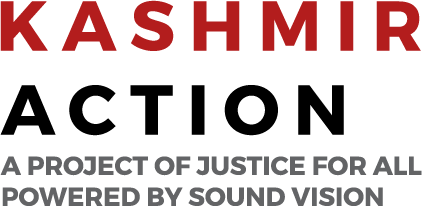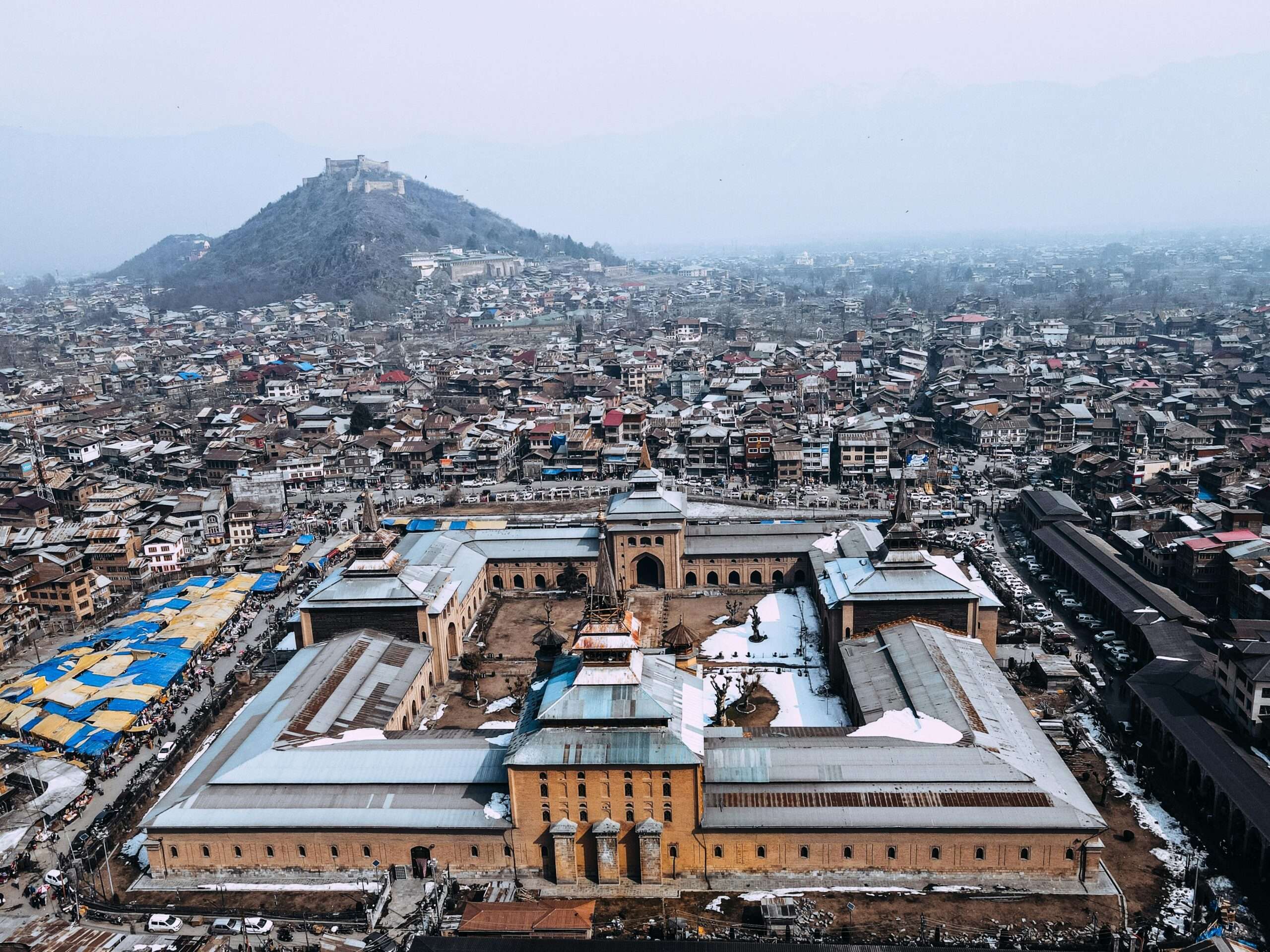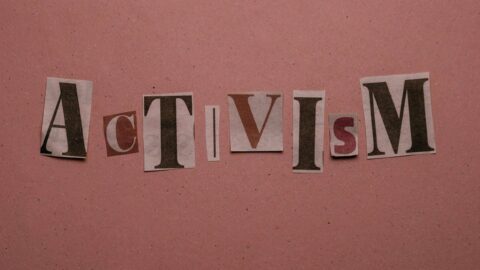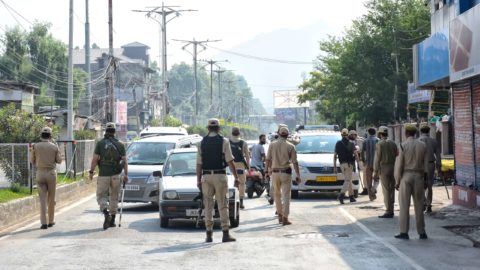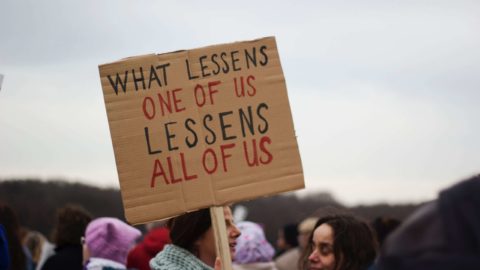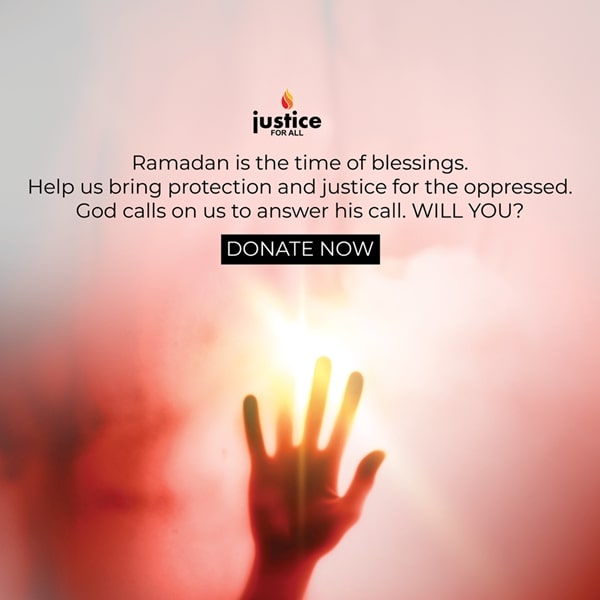As the world celebrates International Women’s Day, many Kashmiri Muslim women languish in Indian prisons…
In Conversation with Kashmiri Pandit scholar Mona Bhan
An interview with Mona Bhan by Ather Zia, first published at Kashmir Lit
Tell us a little bit about your childhood in Kashmir?
I have so many beautiful memories of Kashmir from my childhood; I spent a large portion of my young days in Srinagar since I went to school in the city but I also spent lots of time visiting my parents who worked in several villages across Kashmir. So, while I feel very grounded in Srinagar, I have beautiful memories of living in Tral, Pampore, and Pulwama, places that exposed me to Kashmir’s rural diversity and enabled me to make all kinds of interesting friends, who taught me a lot: from speaking better “accented” Kashmiri to taking quick dips in rivers and streams. Although we stayed in my parent’s medical quarters, I used to spend quality time with my friends thronging the streets of Tral, buying candy (mattam phel), spending time at the Dilnag (the beautiful stream), or waiting enthusiastically for Eid so I could go shopping with them. My parents were loving and caring but never overly protective. On several occasions, I accompanied them to flood sites where the medical staff would distribute calcium tablets to every household. I have distinct memories of attending Muharram processions in the city with an entourage of doctors and paramedics on duty. In Srinagar, I lived with my maternal grandparents, both of whom had lived through very difficult times in Kashmir’s political history. So I grew up in a household where Kashmir’s disputed status was a known and acknowledged fact; there were no illusions about Kashmir being an integral part of India’s geo-body. This is not to argue that all the family members held politically homogeneous views. But because they did not, I realized early on that India’s territorial claims over Kashmir were deeply disputed. Indeed, almost everyday, I used to come home to newspaper cuttings on Kashmir that my grandfather had picked for me to read and analyze.
You are a Kashmiri Pandit, and mass migrations of Pandits is a huge black hole of arguments and counter-arguments between the communities even now, what do you think about what happened and why?
Suffering is a jaded term, albeit one that deeply resonates with Kashmiris who have undoubtedly experienced unexplainable trauma and emotional injury regardless of what community they belong to. Needless to say, Kashmiri Pandit migrations have led to immense suffering; people were forced to live in undignified conditions and suffer various kinds of indignities on a day-to-day basis. But communities who stayed behind in Kashmir also suffer various kinds of indignities on a regular basis. Of course, the convenient explanation used to justify Kashmiri Muslim sufferings is that “they brought it on themselves” but this view is based on a very skewed view of Kashmiri history and its long struggle for freedom and dignity. We have to recognize that if we see the military as the guardian of a social and political order rather than as a fundamental threat to people’s freedoms, dignities, and liberty, we are working to strengthen repressive forces that will eat into the very vitals of our social fabric. This realization is key to begin any kind of a meaningful cross-community dialogue and broaden our understanding of suffering unless we want to remain victims of our experiences.
Now coming to your specific question, people try to obviously come with generic explanations of why Pandits left Kashmir. But to me what is critical is to document as many stories as possible from the times to question generic explanations that are deployed less for human welfare and more to solidify deeply regressive political agendas. The unfortunate thing is that very few people are interested in serious scholarship that could perhaps shed light on the layered history of these times. In the absence of this important work, we will be left with nothing but speculations and some dominant narratives and assumptions that don’t quite capture the complexities of the times. We need to get away from uncritical assumptions to relearn how to love and care and to stand for the truth and embrace it with all its messiness.
Many have rightly spoken about using suffering as a medium to understand and empathize with communities we tend to dehumanize; there is, however, also an urgent need to transcend the conventional vocabulary (and the attendant mindset) that we have used to voice our experiences. Like other words (exodus/migrations etc.), the word suffering is now tainted, evoking self-interest or pity instead of empathy; leading to divisions instead of solidarities; and most importantly, suffering (the ways it is deployed) tends to dehistoricize and depoliticize the long occupation of Kashmir and the fact that for many people in Kashmir, suffering did not begin in 1989. 1989 must be seen as a historic moment in the long continuum of Kashmir’s militarized history not as a rupture, although “experientially” that is what it felt for most people.
When did you leave Kashmir and what were the reasons?
Leaving Kashmir for KP’s has become synonymous with the terms “exodus” and “migrations.” Both terms, however, are associated with way too much ideological baggage. My parents were not “migrants” because they were transferred to Udhampur in the 1990s and were transferred back to Srinagar in 1998. The story, however, is certainly more complex. As doctors they ran a small nursing home in our house in Ishber, Nishat, and at the peak of the armed movement, they treated patients from different walks of life, always telling me how their ethics never permitted refusing treatment to anyone, regardless of their political orientation. There were several instances where my parents were treating young men with bomb-blast injuries and BSF forces walked in for treatment at the same time. These were difficult, and potentially very dangerous, situations to deal with. We were the only KP family left in the neighborhood and every evening, five to six family friends would gather over Kahwa and Roti in our backyard ––– to discuss the events of the day and to reflect on how the future might unfold. Listening to the BBC and the Voice of America was how Kashmiris spent a lot of their time, especially during the long spell of curfews in the 1990s. This is what I meant earlier…we need different stories from the times, not one sweeping narrative that claims to represent the sole truth about the times. We would hear on the BBC that some KP families had left because they were in deep fear. For us, the experience was very different; my parents hadn’t been paid for three months like most other government employees and the local shopkeeper was generous enough to sell us groceries on credit. Because my dad had a curfew pass, I remember him coming back home one day with meat and vegetables for at least ten houses in the neighborhood. And leaving Kashmir, even if briefly, was a consensual decision between us and our neighbors because we didn’t want my parents’ profession to become the pretext for a potential military crackdown in the neighborhood. Unlike other terribly unfortunate stories where KP households could not share their decision of leaving Kashmir with their family or neighbors, our family left after a big feast was organized by our neighbors. In no way did it lessen the pain or the trauma of leaving but we were somewhat happy that before any serious military crackdowns in the neighborhood, my parents were transferred to Udhampur.
Tell us a little about your grandfather? You are working on his biography; why do you think that is significant at this point in time?
My grandfather, Pandit Rughonath Vaishnavi was an avid champion of the Kashmiri right for self-determination. Some know him as the unsung hero of Kashmiri politics, some call him a radical humanist, while others call him an extremist because he fearlessly championed the cause of self-determination for Kashmiris. A lawyer by profession, he spent seven years behind the bars for his stance that Kashmir was not an integral part of India and that accession to India was temporary and, therefore, deeply disputed.
I think it is important to document the long history of dissonance with narratives of the Indian state. It is even more important to do so through the history of Pandit figures in Kashmir’s prolonged war in pursuit of freedom and dignity. My grandfather wrote extensively for the Radical Humanist and the Other Side (the few places where his work was accepted) but he also wrote detailed prison diaries and journals that beautifully and poignantly reflect on the everyday politics of the 1950’s and the 1960s in Kashmir. It is hard to read his stuff and still hold on the naïve belief that 1989 was a “sudden,” “unexpected” rupture in Kashmir’s political culture. In any case, my intent in writing his biography (not sure what the ultimate form will be) is not to represent a new line of Kashmir Pandit thinking (I make no ambitious claims to act as a representative for any community) as much to document the everyday repression of state policies on common Kashmiris who were labeled “dissenters” or as “threats to national security.” I want to use my grandfather’s story to document the lost opportunities that Kashmiri and Indian leaders had to resolve the dispute before things took a drastic turn in 1989. It is also a good time to focus on my grandfather’s archive for various reasons. Kashmiris feel the need to engage with their past and present through creative means be it through literature, arts, or films. Also there are lesser-known stories and histories people are writing about from the 1950’s and 1960s that question various assumptions about those times. We might agree or disagree with these people but the least we can do is engage with them with an open-mind. Fortunately, this year we were able to institute a lecture series in Pandit Vaishnavi’s name with the intent to open up a dialogue about those times. Of course, it was clear that the government did not want this to happen. For me as an academic, it is very critical that such archives me made public so we can deepen our sense of history rather than live a life of unexamined assumptions.
Why anthropology? A number of Kashmiris, including myself, are drawn to the subject, what do you think the field offers that allows for greater exploration?
Anthropology is not just an academic field of inquiry; it is a way of life, a practice that can teach you to strive for equality and social justice; embrace differences without othering them or subsuming them within dominant cultural or social norms. Although deeply romantic, given that the field like any other has been deeply complicit in furthering deeply regressive state/colonial projects, things changed for the field when it took a critical turn in the 1960s within the context of feminist struggles for social and political justice as well as anti-war radicalism in the US. Since then, anthropology has become deeply invested in questioning regimes of power (institutional or non-institutional) that further oppression, domination, and social injustice. Anthropology trains you to understand political formations, wars, and conflict through the prism of human experience instead of studying them from a state-centric perspective that is overly reductive and problematic (since it is overly invested in maintaining the “health” of the state instead of its people). The study of conflict from a humanist standpoint resonates with the experiences of many young Kashmiris who have experienced extreme trauma and conflict and are tired of state-centric perspectives that (as anyone who has grown up in a conflict zone will tell you) have played a critical role in furthering the status quo and ignoring people’s voices. Rather than being reduced to mere statistic under the pretext of objectivity, Anthropology allows for a deeper, richer exploration of the ways conflict shapes human experience and agency. It can be revolutionary but anthropological praxis must always remain deeply self-aware and introspective for it to realize its revolutionary potential.
Your ethnographic field is Ladakh, why this choice?
I grew up deeply immersed in the politics of Kashmir. I would read articles, letters, and telegrams my grandfather wrote to key national and international figures urging them to resolve the dispute in accordance with people’s aspirations. He was always writing or reading. As a result, I developed a keen interest in understanding the politics, history, and geography of the region. I picked Ladakh to understand Kashmir from a different location, one that was intimately connected with the Valley but provided a different yet critical vantage point to think about the region, its people, and its politics.
Now coming to your book, which was published by Routledge titled “Counterinsurgency, Democracy, and the Politics of India: From Warfare to Welfare” please give a little background about this project?
The book is based on extensive ethnographic fieldwork that I conducted from 1999 to 2012 in the Batalik sector of district Kargil. In the book, I show how institutions of democracy and citizenship are being undermined through extensive militarization of border areas, often through programs meant to “win people’s hearts and minds.” I started my work in the region in October 1999 soon after the Kargil war had ended. Although the war was officially over, the aftermaths were clearly visible: people’s shattered window panes, pieces of Bofors shells lying on the national highway and on people’s fields, memories and nightmares from the war were all over the place. And so were the intense war preparations by the military of which Op Sadhbhavana was a part. I was curious to see how a marginal border community participated in the war effort and was profoundly shaped by state and military policies that were instituted in the post-war period. In the book, I show how welfare can become a new mode of warfare; more particularly, I discuss the ways discourses of welfare and humanitarianism are deployed as counterinsurgency tactics to control hearts and minds.
You study Operation Sadhbhavana, tell us what you think of militarized humanitarianism, its history and its implementation in Kashmir region?
Of course, such experiments are not unique to Kashmir. There is a need to situate the Indian military’s tactics within a larger counterinsurgency doctrine that the US implemented in Vietnam during the World War II and more recently with fuller force and urgency in Iraq and Afghanistan. I trace the Indian military’s experiments in Kashmir to a larger post-cold war shift in which poverty and underdevelopment were seen as new threats that could culminate in prolonged low-intensity conflicts across the globe. Development therefore became the new weapon to battle insurgents or potential insurgents whose poverty and deprivation, it was surmised, would eventually drive them to wage asymmetrical wars of the future. As a counterinsurgency tactic, development blurred the tenuous boundary between militarism and humanitarianism to forge a sociopolitical order in which projects of social improvement, compassion, and betterment provided an ideal framework to strengthen the military’s reach and credibility in conflict zones. Humanitarianism has also been used to legitimize military interventions in recent years, a situation not that different from Kashmir where the political genealogy of the dispute is thoroughly undermined through empty tropes of alienation, unemployment, and underdevelopment. This is not to say that such problems don’t exist but to use them to gloss over significant questions or divorce such issues entirely from the larger history of Indian rule over Kashmir is to focus on the symptoms and not the ailment.
What kind of civilian subjectivities emerge under such projects and what are the disadvantages that people face in this context?
It is hard to generalize the kinds of civilian subjectivities that have emerged or continue to emerge in Kashmir when projects such as Sadhbhavana are implemented. My focus in the book is on Brogpas, a small ethnic minority community who live in four villages along the line of control and have long been marginalized from the social and political mainstream of the state. Of course, the process of minoritization is a complex one and often the result of state policies that tend to reinforce differences among people as a strategy of governance. For a community that feels excluded because of their culture or language and also because of their minority status, democracy and citizenship are elusive concepts. Ironically, the Kargil war brought the community a great deal of attention from the state and military agencies who obviously saw them as the first lines of defense against Pakistani “intruders” but also as potential suspects whose allegiance to India needed to be secured. The extensive militarization of Brogpa social life in the postwar period therefore affected every aspect of their existence: from their livelihood choices to their dreams and aspirations for a “good” life to core questions about identity, history, and belonging. Needless to say, the effects of Sadhbhavana were the extensive militarization of social and community life; the military became a constant presence in border villages that normalized its existence even more; the military was also seen as an avenue for employment and social prestige. You have to understand that only a decade or so ago, people feared the military. I was told that people would hide behind big boulders if they saw an army truck approaching. The Kargil war changed all of that as the military decided to make inroads into community life, a shift that, as I argue in the book, had severe consequences for the ways people thought of their collective histories and identities.
How does your study though specifically focused on Brogpas, unsettle the silences around the contestations around LoC especially with the people in AJK and Kashmir valley?
It was clear to me on many different occasions and almost on a daily basis that the LoC was not just an imaginary boundary demarcating fragile nation states. The LoC was a site of memorialization and nostalgia since it signaled the violent ruptures in Brogpa history. For many Brogpas as well as for Kargilis, the LoC cut through their villages and fields, splitting kith and kin while eroding shared social networks and institutions. For Brogpas, the festival of Bono-nah, a harvest festival that was also celebrated in Ganoks, a village now in Pakistan, symbolizes these ruptures. It represents the impossibility of sharing joys and sorrows across the border although the sentimentality associated with this shared past is what enables them to clearly see the unnaturalness of the LoC, its everyday violence, and the silences it imposes on border communities for whom the power of recalling and reminiscing is a tool to defy the imaginary lines carved by nation-states. Of course, in many ways, the boundaries have also hardened as state and military policies continue to naturalize the LoC, presenting it as a frontier separating two organically distinct nation states. And such policies have also fragmented communities in Ladakh, pitting Buddhists against Muslims in a place where such distinctions hardly mattered only several decades ago.
Your study shows that Sadhbhavana ends up fueling strategic exclusions rather than creating inclusions and also many of your respondents from the army are not that enthusiastic about the project; then what does it achieve?
What Sadhbhavna achieves in the end is the license to monitor social and community life under the garb of human welfare and development, which it what it was essentially meant to do. I argue in the book how the language of welfare or compassion normalizes the brutality of realpolitik, cloaking repression as benevolence while allowing the military to demand more land, labor, and resources from civilian populations. In Ladakh, Sadhbhavana was based on the assumption of “disloyalty” more from Muslim communities than their Buddhist counterparts. Where relationships between the two religious groups were already deeply politicized given the unfortunate events of the mid 1990s when a social boycott against Muslims was instituted by the Ladakh Buddhist Association, Sadhbhavana fueled and indeed deepened the existing mistrust between the two communities. Unfortunately, thus, the program shaped in very fundamental ways the texture of social and intercommunity relationships in Ladakh. Although its stated goal was to “include”/“assimilate” Muslims or other such border communities whose allegiance towards India was still inchoate (incipient terrorists as they were called) Sadhbhavana fostered deeper exclusions through its discourse of disloyalty. Despite the stated coherence of the program, there were army officials on the ground who resented the program because they saw it as a colossal waste of military resources on “civilian” populations. More importantly, as I argue in the book, many in the military felt that Op Sadhbhavana and its language of humanism feminized the military, which went against the very grain of an institution that thrives on aggressive masculinities and violent warfare.
There is a recurrent motif of the army’s pre-emptive anticipation of disloyalty on the part of Muslim populations in Ladakh region, what does that stem from, is it connected to their aspirations of Independence which are similar to people in the Kashmir valley or the regions of the other side of the LOC?
The military’s angst stemmed from the perception that Kargili Muslims by virtue of their religion could align or were already aligned with Kashmiris. Indeed, Lt. Gen. Arjun Ray, the architect of Sadhbhavana, was very explicit about “not wanting Ladakh to go the Kashmir way.” In his view, he had seen and felt enough to know that there was a possibility that the deep-seated alienation of Kargilis could culminate into an armed resistance against the Indian state. He often cited stray examples from border areas like Turtuk, an area of Ladakh, which until recently was under Pakistan, to substantiate his fears. Also, the Kargil war, he and others in the Indian military believed, wouldn’t have happened if locals had not supported Pakistani “incursions” into Indian territory. As a border population, Kargilis are under tremendous pressure to perform a particular kind of loyalty towards India that includes working for the military as porters etc. I discuss this phenomenon at length in the book and show both the coercive and institutionalized dimensions of this kind of invisible civilian labor on the border. Kargili day to day struggles are different from the ones Kashmiris experience although these cannot be divorced from each other. For instance, Kargilis want better connectivity given that the only road that connects them with Kashmir and parts of India is the NH1. Of course, Kargilis have a rich history of being at the center of the Central Asian trade route that connected them with many different states and trade networks. Recently, Kargilis opened a museum to celebrate precisely these kinds of links that unfortunately don’t exist anymore. Articles once sold and bartered on the trade route remind Kargilis of their vibrant economic and social histories. The aspiration to regain that status rather than be seen as a military outpost in India’s periphery is a deeply felt one. This, too, obviously poses a threat to existing notions of territory and sovereignty.
Can you take us through how the militarized regime of nation-making under the garb of compassion is diminishing Indian democracy which you forcefully argue throughout?
For any Kashmiri, the term democracy is a big farce given how electoral rituals have only strengthened a brutal military regime over the years. In Ladakh, however, the military’s role in democracy has hardly been questioned, because it has more than often been portrayed as an indispensable institution that provides people employment and amenities to survive in a cold and remote desert. Of course then, there is all the more reason that the military’s role and indispensability in Ladakh be challenged. The first thing about militarized governance is that it is inherently repressive. It affects not only what people can or cannot do, whether or not they can access their own land and resources, but, most importantly, it also defines the limits of what can be said or thought. Of course, the hallmark of a vibrant democracy is the ability to dissent. What I noticed in the village was a deliberate suppression of anything that could be deemed “seditious” and unfortunately the bar wasn’t too high. For instance, older people were discouraged from confessing that in 1948, it didn’t matter to them if their villages had ended up in Pakistan. People who lived that time in history know how contingent their inclusion in India was but you couldn’t have said this without being branded a spy or an antinational. Or people were increasingly reluctant to accept that their immediate ancestors could be Muslims or that their religious identities were not very well defined. To me, this deliberate erasure of history to ensure conformity and not be penalized for your memories and identities is a sure defeat of democracy. Apart from that, claiming people’s land and resources and using them to install guns and weaponry under the pretext of national security is also how democracy is undermined. To me when the discourse of national security remains unchallenged, democratic and critical thinking suffer tremendously and citizenship is profoundly undermined.
How are the Brogpas doing now? Towards the end we get the feeling in the book that this tiny marginalized community has resorted to living under militarized governance and in fact are joining army? Is that so?
Many Brogpas, like other border villagers in Ladakh, joined the army soon after the Kargil war. One big reason was that Ladakh Scouts was declared a regiment and eligibility criteria for enlisting into the military were lowered. In the absence of viable jobs, villagers had very few options but to enlist. I discuss in great length how the subsistence economy of Brogpas that relied on certain marital practices and land sharing arrangements has consistently been eroded due to state policies aimed at modernizing Ladakh’s social and economic sectors, a fact that contributed a great deal to their dependence on the military for jobs and employment. I think it is also a critical time for Brogpas because intense militarization is now accompanied by the presence of right-wing groups like the RSS who are reinforcing popular perceptions of Brogpas as the purest Aryans in an attempt to present Aryans as indigenous to India. Such a claim is designed to validate India’s Hindu origins at the expense of demonizing other minority and religious groups. Of course, there are several noticeable changes at the village level as well: many women think young aspirants who want jobs in the government and/or the military end up contributing nothing to agricultural or household chores (which was not the case with the previous generation) and for many women, there has been a shift in their moral universe, which is attributed to changing food habits and to the shifting division of labor between men and women. They don’t directly attribute such shifts to the extensive militarization of Brogpa life but it is clear that notions of masculinity have also undergone a tremendous shift because of which relationships between men and women has changed a whole lot, and not always for the better.
What is the equation between the military and the civil servants in the region? Your research points to a deep dissonance between them given the hegemonic role of the army?
The relationship between the military and the civil administration or the one-upmanship of the army that I describe in the book is yet another way democracy is undermined on a daily basis. While there was surface level collaboration between the civilian administration and the military, something the military had to uphold in an electoral democracy, everyday anxieties and ego tussles between military officials and civil administrators (from different ranks) was all too common. The SP could be prevented to visit certain border sites if the army deemed it necessary to keep civilians away; likewise, misdemeanor by military officials and their condescending attitude also heightened tensions intermittently. Such moments allowed me to see the seemingly innocuous ways civilian power was eroded on a daily basis. Indeed, a lot of egos were ruffled over Sadhbhavna activities and the military’s “cosmetic” approach towards civilian welfare and development was deeply resented.
Well knowing the military has a lethal and hegemonic hold on the entire area, and entrants have to pay some kind of obeisance to them; and even you unwittingly ended up drafting a ten-page orientation guide for newly deployed soldiers. Tell us about that experience? How did you feel? It must have been a throwback to the classic notoriety we anthropologists have to contend with (cue Evans Pritchard in the Sudan), not that bad but equally. Tell us about that interesting encounter?
Oh yes, absolutely horrific now that I understand its fuller implications. Drafting a ten page orientation guide for the military was supposed to provide a brief account of Brogpa life for incoming officers and soldiers: the festivals they celebrated, their marital practices, basically the guide was meant to present a very generic and homogenizing account of their culture. For obvious reasons, I was extremely reluctant to Orientalize Brogpas further given that anthropologists have been deeply complicit with such colonial endeavors. But it was impossible to say no to the military in a region where they are such an overwhelming force. Besides, many villagers who thought their culture and community was finally getting its due attention also wanted me to write the booklet. In a nutshell, I was under tremendous pressure to write it. I felt terribly exploited but also deeply torn even though quite honestly I didn’t see it as a counterinsurgency strategy at the time. A few years later, as I was talking to one of my ROTC students in the US, this issue came up and he told me how part of their training was to collect detailed information about seemingly innocuous things from people: for instance, what they ate, what they wore etc. as a way to keep track of any anomalous or sudden change in the community. In the context of Ladakh, a border site, any change in people’s dietary habits or other routines could indicate anything from “trade relations” with forbidden neighbors or even “infiltration” from across the border. So how I describe this incident in the book is as a non institutionalized form of US’s Human Terrain System but potentially as dangerous and intrusive. The concern with any scholarly or journalistic work is that once it is out in the public domain, we can no longer control the way our data is used by state or non-state agencies. This means that as conscientious researchers we must always be attentive to ways our data can be misused…obviously, the scary part it is not always easy to do this or know beforehand since even the most “innocuous” data can become politically volatile under charged circumstances.
You have several other projects to your credits, do tell about those?
Right now, I am working on the politics of water between India and Pakistan, focusing in particular on the Kishanganga dam that is being built in Gurez and Bandipora. I am interested in the ways in which local communities in Gurez and Bandipora engage with the dam, locally called the “project,” that is causing massive displacements as well as hurting their livelihoods and the environment. Of course, all this is being done in the name of development but we have to see how such displacements work to divest people off their land and resources and transfer them to power corporations. My work deals with the numerous ways the government and corporations (like the NHPC and the HCC) resort to civilizing tropes of progress and employment to align Kashmiris with new regimes of rule and order. My other project on Kashmir dealt with the politics of environmentalism and the numerous ways nature has become the locus of politics and counterpolitics in Kashmir.
Ather Zia is a poet-writer and founder-editor of Kashmir Lit. She is faculty at Department of Anthropology and Gender Studies at University of Northern Colorado. She is working on an ethnography on Custodial Disappearances enforced by the Indian army in Kashmir valley.
Mona Bhan, associate professor of anthropology at DePauw University, is the author of Counterinsurgency, Democracy, and the Politics of Identity in India: From Warfare to Welfare?. The book has just been published by Routledge as part of its Contemporary South Asia Series.
